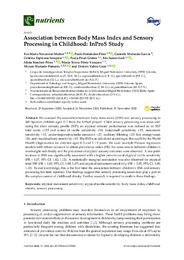Por favor, use este identificador para citar o enlazar este ítem:
https://hdl.handle.net/11000/31288Registro completo de metadatos
| Campo DC | Valor | Lengua/Idioma |
|---|---|---|
| dc.contributor.author | Navarrete-Muñoz, Eva María | - |
| dc.contributor.author | Fernández Pires, Paula | - |
| dc.contributor.author | Mubarak-García, Carmela | - |
| dc.contributor.author | Espinosa-Sempere, María Cristina | - |
| dc.contributor.author | Peral-Gómez, Paula | - |
| dc.contributor.author | Juárez Leal, Iris | - |
| dc.contributor.author | Sánchez-Pérez, Alicia | - |
| dc.contributor.author | PÉREZ VÁZQUEZ, MARÍA TERESA | - |
| dc.contributor.author | HURTADO-POMARES, MIRIAM | - |
| dc.contributor.author | Valera-Gran, Desirée | - |
| dc.contributor.other | Departamentos de la UMH::Patología y Cirugía | es_ES |
| dc.date.accessioned | 2024-02-08T11:47:10Z | - |
| dc.date.available | 2024-02-08T11:47:10Z | - |
| dc.date.created | 2020-11-29 | - |
| dc.identifier.citation | Nutrients. 2020 Nov 29;12(12):3684. | es_ES |
| dc.identifier.issn | 2072-6643 | - |
| dc.identifier.uri | https://hdl.handle.net/11000/31288 | - |
| dc.description.abstract | We assessed the association between body mass index (BMI) and sensory processing in 445 Spanish children aged 3-7 from the InProS project. Child sensory processing was measured using the short sensory profile (SSP); an atypical sensory performance was defined as an SSP total score <155 and scores of tactile sensitivity <30; taste/smell sensitivity <15; movement sensitivity <13; under-responsive/seeks sensation <27; auditory filtering <23; low energy/weak <26; and visual/auditory sensitivity <19. The BMI was calculated according to the cutoffs by the World Health Organization for children aged 0-5 and 5-19 years. We used multiple Poisson regression models with robust variance to obtain prevalence ratios (PR). No associations between children's overweight and obesity and the prevalence of atypical sensory outcomes were observed. A one-point increase in BMI was significantly associated with a higher prevalence of atypical tactile sensitivity (PR = 1.07, 95% CI: 1.02; 1.12). A statistically marginal association was also observed for atypical total SSP (PR = 1.03, 95% CI: 1.00; 1.07) and atypical movement sensitivity (PR = 1.05, 95% CI: 1.00; 1.10). To our knowledge, this is the first time the association between children's BMI and sensory processing has been reported. Our findings suggest that sensory processing issues may play a part in the complex context of childhood obesity. Further research is required to confirm these findings. | es_ES |
| dc.format | application/pdf | es_ES |
| dc.format.extent | 13 | es_ES |
| dc.language.iso | eng | es_ES |
| dc.publisher | MDPI | es_ES |
| dc.rights | info:eu-repo/semantics/openAccess | es_ES |
| dc.rights | Attribution-NonCommercial-NoDerivatives 4.0 Internacional | * |
| dc.rights.uri | http://creativecommons.org/licenses/by-nc-nd/4.0/ | * |
| dc.subject | atypical movement sensitivity | es_ES |
| dc.subject | atypical tactile sensitivity | es_ES |
| dc.subject | body mass index | es_ES |
| dc.subject | childhood obesity | es_ES |
| dc.subject | sensory processing | es_ES |
| dc.title | Association between Body Mass Index and Sensory Processing in Childhood: InProS Study | es_ES |
| dc.type | info:eu-repo/semantics/article | es_ES |
| dc.relation.publisherversion | https://doi.org/10.3390/nu12123684 | es_ES |

Ver/Abrir:
Association between Body Mass Index and Sensory.pdf
278,39 kB
Adobe PDF
Compartir:
 La licencia se describe como: Atribución-NonComercial-NoDerivada 4.0 Internacional.
La licencia se describe como: Atribución-NonComercial-NoDerivada 4.0 Internacional.
.png)